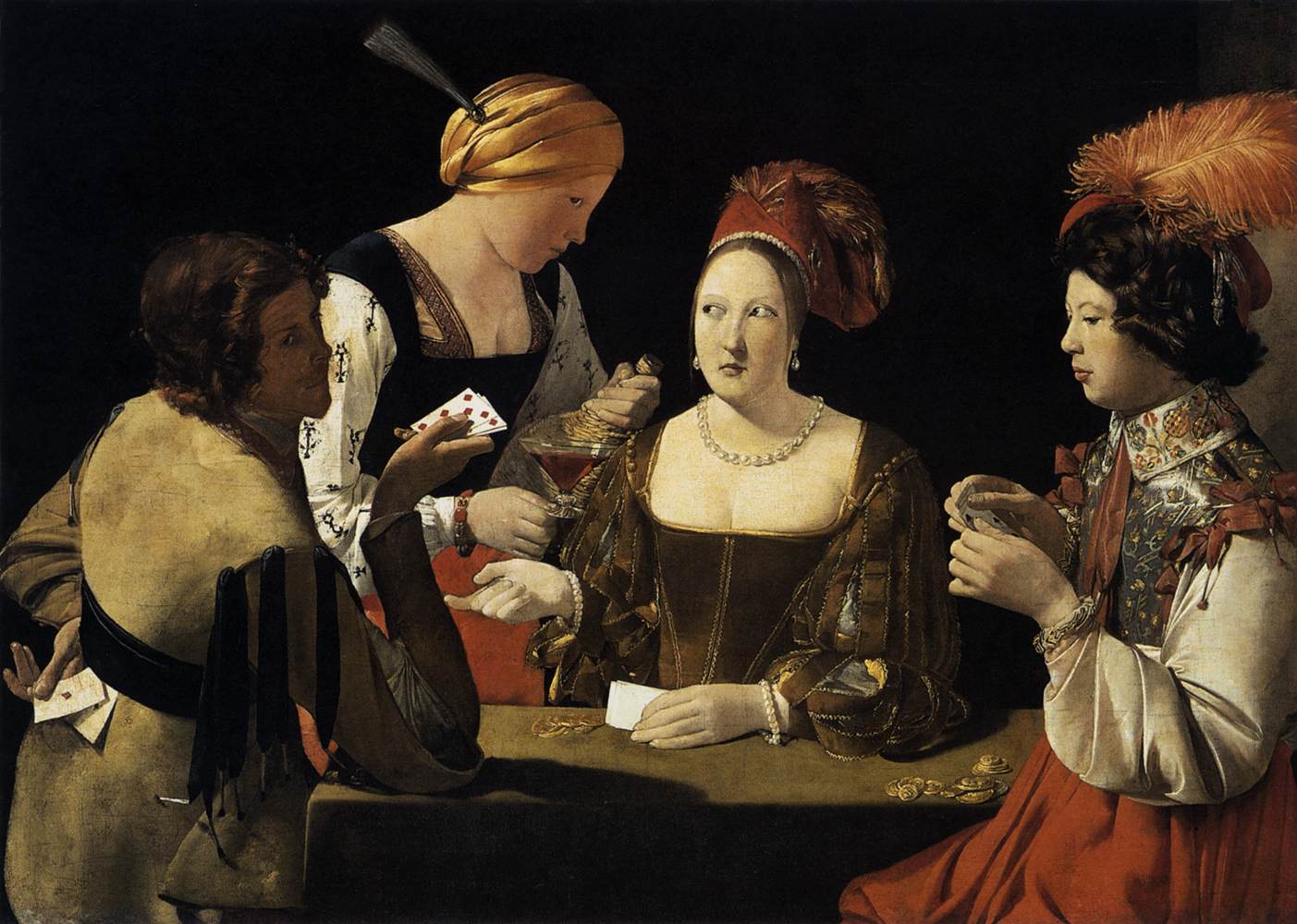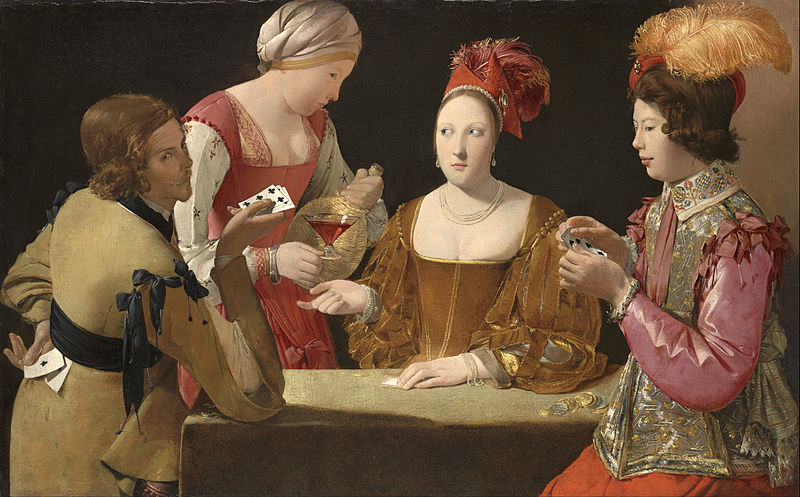.

Cheater with the Ace of Diamonds: Georges de La Tour (1593-1652), 1635, oil on canvas, 106 x 46cm (Musée du Louvre, Paris)
La Tour’s gambling pictures are rather different in atmosphere and intent.
Here, the mood is comic, as a crew of practised tricksters gang up on a well-dressed young dupe and proceed to fleece him at cards. The game is primero, a forerunner of poker, and contemporary viewers with any experience of the game would have known that the cards the sharpers are about to play will make an unbeatable grand point or full house.
The subject can be traced back to Caravaggio, whose cheat looks so obviously menacing -- a young tough straight off the Roman streets -- that only a very innocent dupe indeed could possibly be taken in by him. Again, La Tour dispenses with the low-life aspect and turns instead to the drama of deception inscribed in the players’ faces. A splendidly attired courtesan signals to her accomplice that now is the moment to play the concealed ace, while her sidelong glance cues her maid to step forward with the wine and cause a diversion. As with his religious scenes, La Tour uses lighting and the meanings of lighting as the basis of his picture, though now in a register of profane rather than sacred illumination.
The villains’ success depends on manipulating both what they show and what they conceal, and the lighting works with them; the courtesan, in her gleaming pearls and jewels, deceives through her brilliant appearance, while her accomplice hides his face and his secret cache of cards in the shadow. If, in La Tour’s meditative nocturnes, light is handled so as to imply inwardness and withdrawal from the world, here, the light is very different: flat and external, it stays with the surfaces of things, a worldly light that is the exact opposite of the nocturnes’ light of conscience.
La Tour’s pictures of gamblers, cheats and fortune-tellers are works whose immediate narrative appeal seems to collapse the historical interval between ourselves and the seventeenth century; no viewer needs to know the rules of primero to see who is cheating whom.
Norman Bryson: from Bring them out of the light: a review of Georges de La Tour and His World at the National Gallery of Art, Washington, D.C., in TLS, 20 December 1996
The Cheat with the Ace of Clubs: Georges de La Tour (1593-1652), 1630-34, oil on canvas, 97.8 x 156.2 cm (Kimbell Museum of Art, Fort Worth)

The Cheat with the Ace of Clubs (detail): Georges de La Tour (1593-1652), 1630-34, oil on canvas (Kimbell Museum of Art, Fort Worth)

The Card Players: Theodor Rombouts (1597-1637), n.d., oil on canvas (Residenzgalerie, Salzburg)

The Cheat with the Ace of Clubs (detail): Georges de La Tour (1593-1652), 1630-34, oil on canvas (Kimbell Museum of Art, Fort Worth)

The Card Players: Theodor Rombouts (1597-1637), n.d., oil on canvas (Residenzgalerie, Salzburg)

The Cardsharps: Caravaggio (1573-1610), c. 1596, oil on canvas, 92 x 129 cm (Kimbell Museum of Art, Fort Worth)

The Cardsharps (detail): Caravaggio, c. 1596, oil on canvas (Kimbell Museum of Art, Fort Worth)




10 comments:
The con springs eternal.
Would you trust this man?
"You wanna be a grifter?"
In his religious scenes Georges de La Tour reverses the angle of illumination, directing the viewer's attention away from the complex dynamics of this shady "profane" world of gaming and being gamed, gulling and being gulled, and turning it inward, to the privacy and immanence of solitary figures in candlelight.
Tom,
From house of cards to cardsharps -- those four hands in the detail of La Tour's painting, the Courtesan's right with pearls wrapped around wrist, maid with jug in left and triangular glass with wine in right, the "cheater" with 6 of clubs in his right (and look what's hidden in his left) . . . what's shown and what's concealed (move over Ricky Jay).
4.29
light coming into sky above black plane
of ridge, waning white moon by branches
in foreground, sound of wave in channel
condition of gravity rather,
there exists in space
comparison with, shows that,
term on the left side
blue white of sky reflected in channel,
clouds on horizon to the left of point
The eyes of the third woman along in the La Tour are startling.
I remember seeing Ricky Jay on British television many years ago now. That silence is something fierce.
Love that smug, menacing look of Jay's.
gamblers should understand body language...
I was about to say it is all there in the eyes, but Sandra is right, it's about the whole body's language. The painter was so good at telling his story he didn't need to illuminate one particular person, hands, face only, to hint at what is going on right now.
The solitary and pensive Magdalene, so beautiful...
The idea of cheating --
I was on jury duty today, got seated and then dismissed
for asking too many questions . . .
It's such an odd world with the powers all on one side, and so obviously so. The deck is always stacked. And I can't not question the situation.
The eyeline dynamics in the Louvre version of Cheater with the Ace of Diamonds seem to have just that jot more of wickedness than in the Fort Worth version (probably done a bit earlier); it's as though de La Tour were only gradually coming to terms with the darkness of the world that's implied in this circle of deceit and machination -- perhaps that same darkness of "fallen"-ness which also surrounds his inward-gazing Magdalene.
Ricky Jay has appeared in a number of David Mamet's movies; it appears Mamet has learned a good deal about cinematic construction from him.
The Mamet film that explores the twisted underworld of confidence rackets most thoroughly is his first, House of Games (1987). It opens with a fictional short con devised by Mamet's gaming tutor, Jay.
House of Games
(Ricky Jay -- real name Richard Jay Potash -- also appears in Mamet's films The Spanish Prisoner, Homicide, Things Change, State and Main and Heist.)
Nin, I hear you -- the awful stacked-deck aspects of the proceedings, like being run over again and again...
Post a Comment